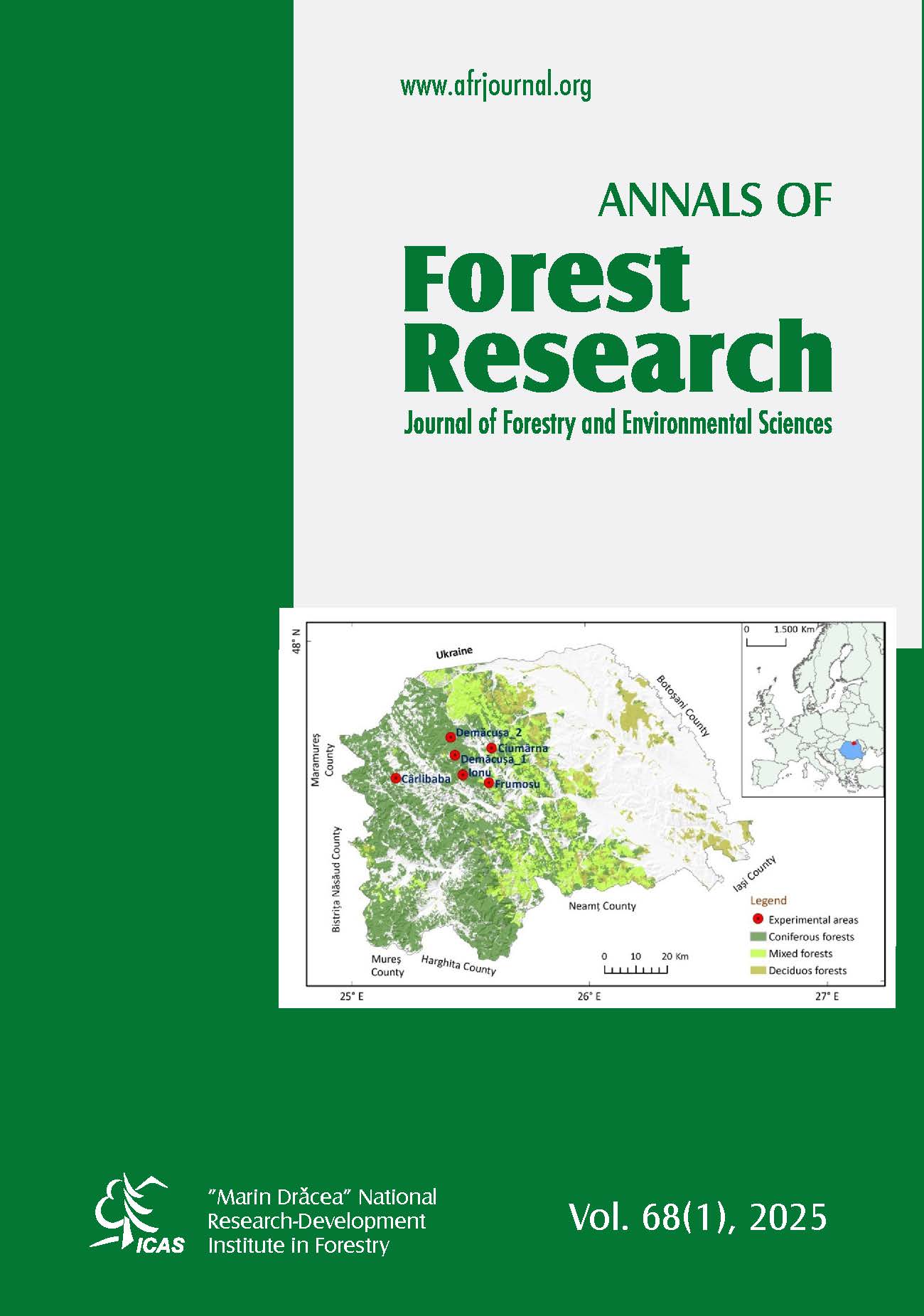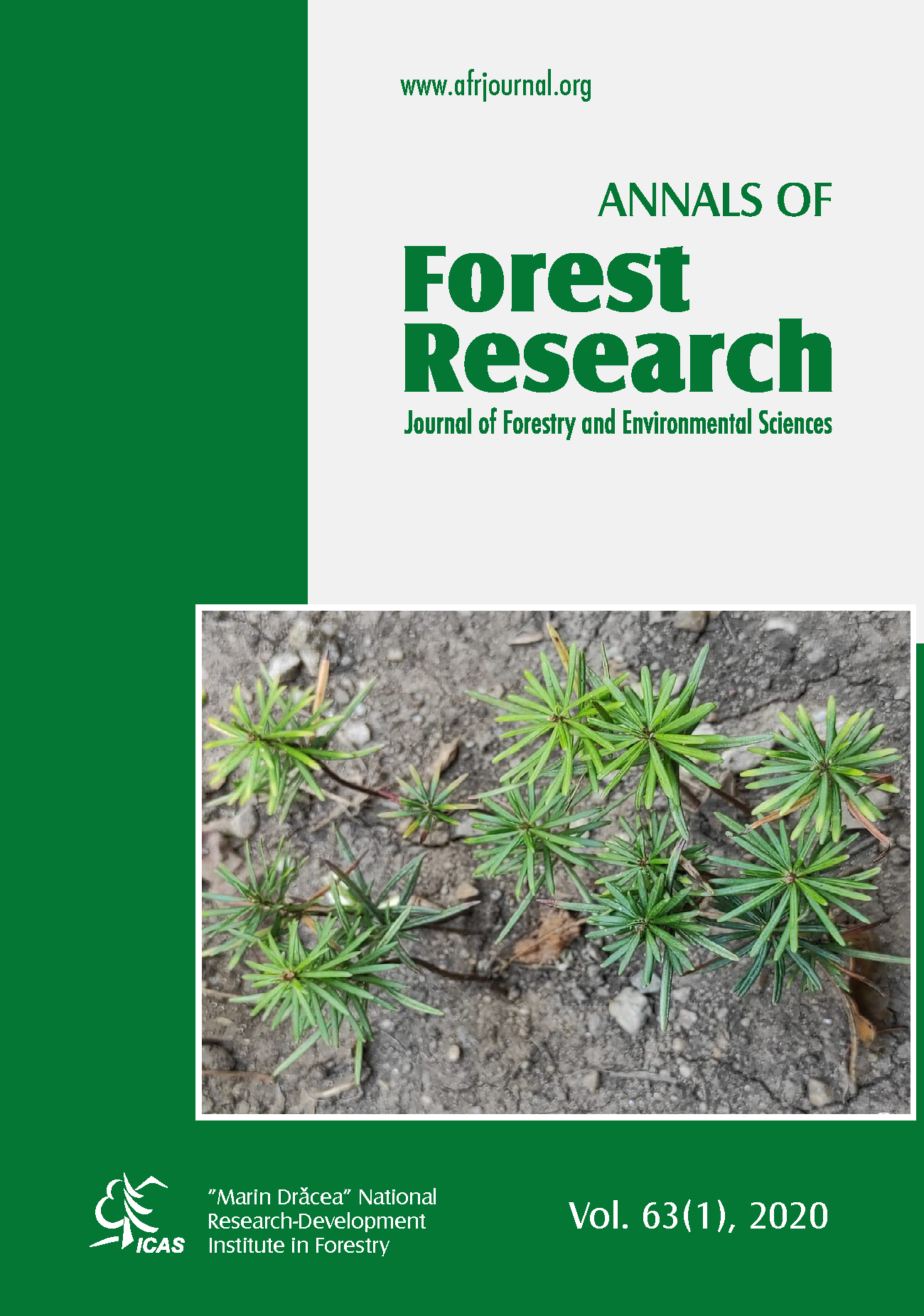Development of acorn discrimination model for warm-temperature evergreen oaks using hyperspectral analysis
DOI:
https://doi.org/10.15287/afr.2025.4012Keywords:
hyperspectral analysis; seed identification; variable selection; evergreen oak; species classificationAbstract
We used hyperspectral analysis to distinguish between acorns of Japanese red oak (Quercus acuta Thunb.) and ring-cup oak (Quercus glauca Thunb.), two closely related species of the evergreen oaks. To accomplish this, 631 Japanese red oak acorns and 505 ring-cupped oak acorns were collected from the seed orchard in Jeju Island, Korea, and hyperspectral imaging was performed. Two types of hyperspectral devices, Corning and Korea Spectral Products (KSP), were used to calibrate images and extract regions of interest. Average spectra were obtained from the extracted regions of interest, and morphological variables were added to the Corning data to form a dataset. Partial least square (PLS) was used as the learning model, Standard normal variate, Multiplicative scatter correction, and Savitzky-Golay filtering were applied as preprocessing techniques, and competitive adaptive reweighted sampling and successive projection algorithm were applied as variable selection techniques ; and the combination of preprocessing method, the number of PLS components, and the number of selected variables were optimized.. The lightweight model was generated from the selected variables, and the performance was improved by combining the morphological variables. As a result, the lightweight model based on Corning dataset showed 45~85% accuracy, and the lightweight model based on the KSP dataset showed 75~90% accuracy. The model utilizing morphological variables in the Corning-based lightweight model showed a high accuracy of 98-100%, so we were able to discriminate the acorns of evergreen oaks between Q. acuta and Q. glauca. The results of this study are expected to serve as a basis for future model development for seed classification of hybrid oak acorns.
References
Bacherikov I.V., Raupova D.E., Durova A.S., Bragin V.D., Petrishchev E.P., Novikov A.I., Danilov D.A. and Zhigunov A.V. 2022. Coat colour grading of the scots pine seeds collected from faraway provenances reveals a different germination effect. Seeds 1: 49-73. https://doi.org/10.3390/seeds1010006
Boelt B., Shrestha S., Salimi Z., Jørgensen J.R., Nicolaisen M. and Carstensen J.M. 2018. Multispectral imaging – a new tool in seed quality assessment? Seed Science Research 28: 222-228. https://doi.org/10.1017/S0960258518000235
Bonner F.T. and Vozzo J.A. 1987. Seed biology and technology of Quercus. U.S. Department of Agriculture, Forest Service, Southern Forest Experiment Station.
Dilillo N., Sanna A., Belcore E., Smith K., Piras M., Montrucchio B., Ferrero R., 2025. Enhancing lettuce classification: Optimizing spectral wavelength selection via CCARS and PLS-DA. Smart Agricultural Technology, 11, 100962. https://doi.org/10.1016/j.atech.2025.100962
Farhadi M., Tigabu M., Stener L.-G. and Odén P.C. 2016. Feasibility of visible + near infrared spectroscopy for non-destructive verification of European × Japanese larch hybrid seeds. New Forests 47: 271-285. https://doi.org/10.1007/s11056-015-9514-4
Feng X., Peng C., Chen Y., Liu X., Feng X. and He Y. 2017. Discrimination of CRISPR/Cas9-induced mutants of rice seeds using near-infrared hyperspectral imaging. Scientific Reports 7: 15934-10. https://doi.org/10.1038/s41598-017-16254-z
Feng L., Zhu S., Liu F., He Y., Bao Y. and Zhang C. 2019. Hyperspectral imaging for seed quality and safety inspection: A review. Plant Methods 15: 91. https://doi.org/10.1186/s13007-019-0476-y
Fu X., Bai M., Xu Y., Wang T., Hui Z., Hu X., 2023. Cultivars identification of oat (Avena sativa L.) seed via multispectral imaging analysis. Frontiers in Plant Science, 14, 1113535–1113535. https://doi.org/10.3389/fpls.2023.1113535
Gariso R., Coutinho J. P. L., Rato T. J., Reis M. S., 2025. A comparative analysis of deep learning and chemometric approaches for spectral data modeling. Analytica Chimica Acta, 1347, 343766. https://doi.org/10.1016/j.aca.2025.343766
Gehan M.A., Fahlgren N., Abbasi A., Berry J.C., Callen S.T., Chavez L., Doust A.N., Feldman M.J., Gilbert K.B., Hodge J.G., Hoyer J.S., Lin A., Liu S., Lizárraga C., Lorence A., Miller M., Platon E., Tessman M. and Sax T. 2017. PlantCV v2: Image analysis software for high-throughput plant phenotyping. PeerJ 2017: e4088-e4088. https://doi.org/10.7717/peerj.4088
Gil-Pelegrín E., Peguero-Pina J., Sancho-Knapik D. (eds) 2017. Oaks Physiological Ecology. Exploring the Functional Diversity of Genus Quercus L. Tree Physiology, vol 7. Springer, Cham. https://doi.org/10.1007/978-3-319-69099-5_5
Huang M., He C., Zhu Q. and Qin J. 2016. Maize seed variety classification using the integration of spectral and image features combined with feature transformation based on hyperspectral imaging. Applied Sciences 6: 183. https://doi.org/10.3390/app6060183
Jeong W. H., Harada, K., Yamada T., Abe J., Kitamura K., 2010. Establishment of new method for analysis of starch contents and varietal differences in soybean seeds. Breeding Science, 60(2), 160–163. https://doi.org/10.1270/jsbbs.60.160.
Jia Z., Sun M., Ou C., Sun S., Mao C., Hong L., Wang J., Li M., Jia S. and Mao P. 2022. Single seed identification in three medicago species via multispectral imaging combined with stacking ensemble learning. Sensors 22: 7521. https://doi.org/10.3390/s22197521
Jinnuo Z., Xuping F., Xiaodan L., Yong H., 2018. Identification of hybrid okra seeds based on near-infrared hyperspectral imaging technology. Applied Sciences, 8(10), 1793. https://doi.org/10.3390/app8101793
Kim C.Y., Kim W.M., Song W.K., Cho J.P. and Choi J.Y. 2023. Prediction of native seed habitat distribution according to SSP scenario and seed transfer zones: A focus on Acer pictum subsp. Mono and Quercus acuta. Forests 14: 87. https://doi.org/10.3390/f14010087
Kim H.J. and Lee S.H. 2017. Estimating carbon storage and CO2 absorption by developing allometric equations for Quercus acuta in South Korea. Forest Science and Technology 13: 55-60. https://doi.org/10.1080/21580103.2017.1308888
Kretschmer M., Coumou D., Agel L., Barlow M., Tziperman E. and Cohen J. 2018. More-persistent weak stratospheric polar vortex states linked to cold extremes. Bulletin of the American Meteorological Society 99: 49-60. https://doi.org/10.1175/bams-d-16-0259.1
Lee J.H. and Choi B.H. 2010. Distribution and northernmost limit on the Korean peninsula of three evergreen trees. Korean Journal of Plant Taxonomy 40: 267-273. https://doi.org/10.11110/kjpt.2010.40.4.267
Lee J.H., Jin D.P. and Choi B.H. 2014. Genetic differentiation and introgression among korean evergreen Quercus (Fagaceae) are revealed by microsatellite markers. Annales Botanici Fennici 51: 39-48. https://doi.org/10.5735/085.051.0105
Li H., Liang Y., Xu Q. and Cao D. 2009. Key wavelengths screening using competitive adaptive reweighted sampling method for multivariate calibration. Analytica Chimica Acta 648: 77-84. https://doi.org/10.1016/j.aca.2009.06.046
Mahynski N.A. 2023. PyChemAuth (v0.0.0-beta3). Zenodo. https://doi.org/10.5281/zenodo.10037568
Matsumoto A., Kawahara T., Kanazashi A., Yoshimaru H., Takahashi M. and Tsumura Y. 2009. Differentiation of three closely related Japanese oak species and detection of interspecific hybrids using AFLP markers. Botany 87: 145-153. https://doi.org/10.1139/b08-121
Metrohm NIRSystems 2013. A guide to near-infrared spectroscopic analysis of industrial manufacturing processes.
Michelon T.B., Serra Negra Vieira E. and Panobianco M. 2023. Spectral imaging and chemometrics applied at phenotyping in seed science studies: a systematic review. Seed Science Research 33: 9-22. https://doi.org/10.1017/S0960258523000028.
Michelon T.B., Carstensen J.M., Serra Negra Vieira E. and Panobianco M. 2024. Multispectral imaging for distinguishing hybrid forest seeds of Corymbia spp. and Eucalyptus spp. from their progenitors. Journal of Environmental Management 363: 121383-121383. https://doi.org/10.1016/j.jenvman.2024.121383
Mortensen A.K., Gislum R., Jørgensen J.R. and Boelt B. 2021. The use of multispectral imaging and single seed and bulk near-infrared spectroscopy to characterize seed covering structures: Methods and applications in seed testing and research. Agriculture 11: 301. https://doi.org/10.3390/agriculture11040301
Nie P., Zhang J., Feng X., Yu C. and He Y. 2019. Classification of hybrid seeds using near-infrared hyperspectral imaging technology combined with deep learning. Sensors and Actuators. B, Chemical 296: 126630. https://doi.org/10.1016/j.snb.2019.126630
Pang L., Wang J., Men S., Yan L. and Xiao J. 2021. Hyperspectral imaging coupled with multivariate methods for seed vitality estimation and forecast for Quercus variabilis. Spectrochimica Acta. Part A, Molecular and Biomolecular Spectroscopy 245: 118888. https://doi.org/10.1016/j.saa.2020.118888
Ribeiro-Oliveira J.P. and Ranal M.A. 2014. Sementes florestais brasileiras: Inicio precário, presente inebriante e o futuro, promissor? Ciência Florestal 24: 771-784. https://doi.org/10.5902/1980509815738
Rushton B. 1993. Natural hybridization within the genus Quercus L. Annales des Sciences Forestières 50: 73s-90s
Seo, Y., Lee, A., Kim, B., Lim, J., 2020. Classification of rice and starch flours by using multiple hyperspectral imaging systems and chemometric methods. Applied Sciences, 10(19), 6724. https://doi.org/10.3390/app1019672
Shrestha R. and Hardeberg J.Y. 2015. An experimental study of fast multispectral imaging using LED illumination and an RGB camera. Color and Imaging Conference, Society for Imaging Science and Technology 23: 36-40. https://doi.org/10.2352/CIC.2015.23.1.art00008
Sripada R.P., Heiniger R.W., White J.G. and Meijer A.D. 2006. Aerial color infrared photography for determining early in-season nitrogen requirements in corn. Agronomy Journal 98: 968-977. https://doi.org/10.2134/agronj2005.0200
Tigabu M., Farhadi M., Stener L.G. and Odén P.C. 2018. Visible + Near Infrared Spectroscopy as taxonomic tool for identifying birch species. Silva Fennica 52: 1. https://doi.org/10.14214/sf.9996
Valencia S.A. 2021. Species delimitation in the genus Quercus (Fagaceae). Botanical Sciences 99: 1-12. https://doi.org/10.17129/BOTSCI.2658
Valková, V. 2019., The content and quality of starch in different wheat varieties growing in experimental conditions. Journal of Microbiology, Biotechnology and Food Sciences, 9(Special), 462–466. https://doi.org/10.15414/jmbfs.2019.9.special.462-466
Wang T., Xu L., Lan T., Deng Z., Yun Y. H., Zhai C., Qian C., 2024. Nondestructive identification and classification of starch types based on multispectral techniques coupled with chemometrics. Spectrochimica Acta. Part A, Molecular and Biomolecular Spectroscopy, 311, 123976. https://doi.org/10.1016/j.saa.2024.123976
Yang L., Zhang Z. and Hu X. 2020. Cultivar discrimination of single alfalfa (Medicago sativa L.) seed via multispectral imaging combined with multivariate analysis. Sensors 20: 1-14. https://doi.org/10.3390/s20226575
Yang X., Hong H., You Z. and Cheng F. 2015. Spectral and image integrated analysis of hyperspectral data for waxy corn seed variety classification. Sensors 15: 15578-15594. https://doi.org/10.3390/s150715578
Yun J.-H., Nakao K., Tsuyama I., Higa M., Matsui T., Park C.-H., Lee B.-Y. and Tanaka N. 2014. Does future climate change facilitate expansion of evergreen broad-leaved tree species in the human-disturbed landscape of the Korean Peninsula? Implication for monitoring design of the impact assessment. Journal of Forest Research 19: 174-183. https://doi.org/10.1007/s10310-013-0401-6
Zhang J., Rivard B. and Rogge D.M. 2008. The successive projection algorithm (SPA), an algorithm with a spatial constraint for the automatic search of endmembers in hyperspectral data. Sensors 8: 1321-1342. https://doi.org/10.3390/s8021321
Zongbao S., Junkui L., Jianfeng W., Xiaobo Z., Chi T.H., Liming L., Xiaojing Y., Xuan Z. 2021. Rapid qualitative and quantitative analysis of strong aroma base liquor based on SPME-MS combined with chemometrics. Food Science and Human Wellness, 10(3), 362–369. https://doi.org/10.1016/j.fshw.2021.02.031
Downloads
Published
Issue
Section
License
All the papers published in Annals of Forest Research are available under an open access policy (Gratis Gold Open Access Licence), which guaranty the free (of taxes) and unlimited access, for anyone, to entire content of the all published articles. The users are free to "read, copy, distribute, print, search or refers to the full text of these articles", as long they mention the source.
The other materials (texts, images, graphical elements presented on the Website) are protected by copyright.
The journal exerts a permanent quality check, based on an established protocol for publishing the manuscripts. The potential article to be published are evaluated (peer-review) by members of the Editorial Board or other collaborators with competences on the paper topics. The publishing of manuscript is free of charge, all the costs being supported by Forest Research and Management Institute.
More details about Open Access:
Wikipedia: http://en.wikipedia.org/wiki/Open_access






